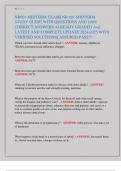1|Pag e
NR601 MIDTERM EXAM|| NR 601 MIDTERM
STUDY GUIDE WITH QUESTIONS AND 100%
CORRECT ANSWERS ALREADY GRADED A+||
LATEST AND COMPLETE UPDATE 2024-2025 WITH
VERIFIED SOLUTIONS|| ASSURED PASS!!!
Which vaccines should older adults have? - ANSWER: tetanus, diphtheria
(TDAP), pneumococcal, influenza, shingles
Between what ages should older adults get colorectal cancer screening? -
ANSWER: 50-75
Between what ages should older women have biennial breast cancer screening? -
ANSWER: 50-74
What are 3 health promotion topics to discuss with older adults? - ANSWER:
smoking cessation, aerobic and strength training, nutrition
What is the purpose of the Beers Criteria for those 65 and older in all setting
except for hospice and palliative care? - ANSWER: reduce older adults' exposure
to potentially inappropriate drugs, educate clinicians and patients, and serve as a
tool to evaluate quality of care, costs, and patterns of drug use in older adults,
reduce adverse drug events
What is the definition of polypharmacy? - ANSWER: older persons who take a lot
of medicines
What happens in the head as a normal part of aging? - ANSWER: decreased brain
wt, slower reaction time, changes in sleep cycle
,2|Pag e
What happens to the eyes as a normal part of aging? - ANSWER: decreased visual
acuity, decreased adaptation to light/dark
What happens to the ears as a normal part of aging? - ANSWER: decreased
hearing acuity
What happens in the chest as a normal part of aging? - ANSWER: ciliary atrophy
(increased risk for infection), reduced cardiac function, increased risk of murmur
and valve stenosis
What happens to the arms as a normal part of aging? - ANSWER: increased risk
of skin tears, decreased thermoregulation, wrinkles, loss of body hair
What happens in the abdomen as a normal part of aging? - ANSWER: decreased
liver size and renal perfusion (up to 50% less)
What happens to the groin as a normal part of aging? - ANSWER: women:
menopause, vaginal atrophy, men: decreases ejaculate/reduced erectile intensity
What happens to the legs as a normal part of aging? - ANSWER: decreased bone
mineral content and muscle mass
Telomere are DNA proteins that shorten with age increasing the risk for cell
damage. What are non-modifiable reasons for shorter telomeres? - ANSWER:
genetics, epigenetics, age
What are modifiable reasons for shorter telomeres? - ANSWER: socioeconomic
status, exercise, excess wt., smoking, diet
,3|Pag e
What are the components of the Rule of Fourths that impact functional decline? -
ANSWER: disease, disuse, physiologic ageing, misuse
________ % of older adults have two or more chronic diseases. - ANSWER: 60
In order to combat the Free Radical Theory of aging, once can slow the cell
damage caused by these reactive molecules by eating a diet rich in antioxidants.
What are the components of such a diet? - ANSWER: fruit and veggies, dark
chocolate, red wine, tea
Which hormone is involved in the signs of aging associated with osteoporosis? -
ANSWER: parathyroid hormone
Which hormone is involved in the signs of aging associated with orthostatic
hypertension? - ANSWER: aldosterone
Which hormone is involved in the signs of aging associated with decreased muscle
mass? - ANSWER: growth hormone
Which hormone is involved in the signs of aging associated with disturbed sleep
cycle? - ANSWER: melatonin
Which hormone is involved in the signs of aging associated with vaginal atrophy? -
ANSWER: estrogen
Which hormone is involved in the signs of aging associated with erectile
dysfunction? - ANSWER: testosterone
, 4|Pag e
What are the physiologic changes of aging in the Immune Theory? - ANSWER:
reduced T-cell, B-cell, lymphocyte (function) and phagocyte production; increased
cytokynes: IL-6, TNF alpha, C-reactive protein
Which theory of aging states aging is due to imbalance between the nervous and
endocrine systems? - ANSWER: Neuroendocrine theory of aging
According to the neuroendocrine theory of aging, which hormones increase with
age? - ANSWER: FSH, LH, norepinephrine, PTH
According to the neuroendocrine theory of aging, which hormones decrease with
age? - ANSWER: aldosterone, calcitonin, growth hormone, renin, estrogen,
prolactin, testosterone
Your older patient scored 12 on the mini nutritional assessment? What is their risk?
- ANSWER: Normal (12-14)
Your older patient scored 10 on the mini nutritional assessment? What is their risk?
- ANSWER: At risk (8-10)
Your older patient scored 4 on the mini nutritional assessment? What is their risk?
- ANSWER: Malnourished (0-7)
How often should health promotion visits be scheduled? - ANSWER: At least
annually
What are the age related changes to the respiratory system? - ANSWER:
decreased lung elastic recoil, airway caliber, expiratory flow, chest wall
compliance, gas exchange, respiratory muscle strength, increased dynamic airway
collapse




